Resources
The latest industry news, interviews, technologies and resources.
Monitoring AWS EKS cluster using AWS Prometheus (AMP) & AWS Grafana (AMG)
Amazon Managed Prometheus is a fully managed backend to ingest, query metrics, store, and visualizes data using Grafana. It is highly scalable, has fast, and secure access to data, and has a unified way of monitoring all containerized applications like AWS EKS.
Amazon Managed Grafana we can be able to create Grafana dashboards and visualizations to analyze your metrics, and logs, and trace our applications. Here would be able to perform native Prometheus Query Language (PromQL) to query the metrics to analyze the data of our Kubernetes cluster.
CREATING AWS PROMETHEUS AND GRAFANA STEPS
Step 1: Create an EKS cluster with a node group
Step 2: Create a workspace in the AWS Prometheus


Mark down the Workspace ID and Endpoint-query URL this will require later.
Step 3: Setting up the Prometheus server in our Kubernetes.
Prometheus server helps to collect all the cluster metrics which is inside our EKS cluster then it will transfer to AMP.
3.1) Execute the following helm commands to add charts
Kubernetes Monitoring with Datadog
Introduction
Kubernetes monitoring is crucial for ensuring the optimal performance, availability, and reliability of your containerized applications running in a Kubernetes cluster. With the complexity and scale of Kubernetes deployments, effective monitoring becomes essential for identifying and resolving issues quickly. Datadog, a popular monitoring platform, provides comprehensive Kubernetes monitoring capabilities. It offers real-time visibility into the health and performance of your cluster, including metrics, logs, and traces. With Datadog, you can gain insights into resource utilization, application performance, and container orchestration. This enables proactive troubleshooting, efficient resource allocation, and effective capacity planning, ensuring the smooth operation of your Kubernetes environment and facilitating application scalability and stability.
1. Prerequisite.
. Install Datadog Agent on EKS
• Install Datadog Cluster Agent
• Configure permissions and secrets
a. Creating ClusterRole, ClusterRoleBinding, and ServiceAccount for allowing permission to cluster agent and datadog agent to collect metrices.
• Creating Kubernetes Secret to provide your Datadog API key
• Deploy the datadog-cluster-agent and datadog-agent on EKS using yaml files. (datadog-cluster-agent.yaml, datadog-agent.yaml.)
Install Datadog Agent on EKS:-
The Datadog Agent is free software that enables you to observe and manage your complete infrastructure in one location by gathering metrics, distributed traces, and logs from each of your nodes and reporting them.
The Agent automatically gathers and provides resource measurements (such as CPU, memory, and network traffic) from your nodes, regardless of the underlying infrastructure platform, in addition to gathering telemetry data from Kubernetes, Docker, and other infrastructure technologies.
Install Datadog Cluster Agent:-
By acting as a proxy between the API server and the node-based Agents, the Datadog Cluster Agent reduces the load on the Kubernetes API server for collecting cluster-level data. It also adds security by lowering the permissions required for the node-based Agents, and it allows Kubernetes workloads to be automatically scaled using any metric that Datadog collects.
Configure permissions and secrets:-
The following manifests can be deployed to create the permissions that the node-based Agent and Cluster Agent will need to function in your Kubernetes cluster if it implements role-based access control. The following manifests provide two sets of permissions: one for the node-based Agent and one for the cluster agent. The cluster agent has rights specifically for gathering cluster-level metrics and Kubernetes events via the Kubernetes API. For each type of Agent, deploying these two manifests will result in the creation of a ClusterRole, ClusterRoleBinding, and ServiceAccount.
2. Tasks To Do.
The Github repository URL is below. In that repository, you can find the configuration file. You must run that file on the EKS Cluster so that the node-based Agent and Cluster Agent may conduct tasks.
https://github.com/frankisinfotech/Datadog-monitoring
kubectl create -f https://raw.githubusercontent.com/DataDog/datadog-agent/master/Dockerfiles/manifests/cluster-agent/cluster-agent-rbac.yaml
kubectl create -f https://raw.githubusercontent.com/DataDog/datad og-agent/master/Dockerfiles/manifests/cluster-agent/rbac.yaml
Create a Kubernetes secret next so you may give the Agent your Datadog API key without include it in your deployment manifests.
kubectl create secret generic datadog-secret — from-literal api-key=”<YOUR_API_KEY>”
In order to provide secure Agent-to-Agent communication between the Cluster Agent and the node-based Agents, construct a secret token as follows:
Create a 32-bit long string using the link below, then use it in the command below.
echo -n <32 String long password> | base64
Use the resulting token to create a Kubernetes secret that both flavors of Agent will use to authenticate with each other:
Use the token in below command which is generated from above command.
Kubectl create secret generic datadog-auth-token –from literal=token=<TOKEN_FROM_PREVIOUS_STEP>
Deploy the Cluster Agent:-
You’re prepared to deploy the Cluster Agent now that you’ve created Kubernetes secrets using your Datadog API key and an authentication token. Copy the manifest file from the aforementioned Gitub repo link to your local computer and save it there as datadog-cluster-agent.yaml:

After copy that file to local you have to run that file on cluster so it will deploy that cluster agent on node, so use below command to deploy agent.
kubectl apply -f datadog-cluster-agent.yaml
For the Cluster Agent, the manifest establishes a Kubernetes deployment and service. The Service offers a consistent endpoint within the cluster so that node-based Agents can communicate with the Cluster Agent, wherever it may be running, while the Deployment ensures that a single Cluster Agent is always running somewhere in the cluster. It should be noted that rather than being saved in plaintext in the manifest itself, the Datadog API key and authentication token are obtained through Kubernetes secrets.
check the status of cluster agent using below command:
kubectl get pods -l app=datadog-cluster-agent

Deploy the node-based Agent:
The node-based Datadog Agent is easy to install to your cluster once the required permissions and secrets have been generated. DD_CLUSTER_AGENT_ENABLED (set to true) and DD_CLUSTER_AGENT_AUTH_TOKEN (set using Kubernetes secrets, much like in the Cluster Agent manifest) are two additional environment variables that are set in the manifest that follows the normal Kubernetes Agent manifest. Save the following manifest as datadog-agent.yaml and copy it to a local file.

Similar to the previous cluster agent, you must copy the datadog-agent file to local storage before deploying the datadog agent on the cluster. Once the node-based Agent is deployed as a DaemonSet, use the following command to make sure that one instance of the Agent is running on each node in the cluster.
kubectl apply -f -f datadog-agent.yaml
To verify that the node-based Datadog Agent is running on your cluster, run the following command:
kubectl get daemonset datadog-agent
After this all the configuration you will be able to see the resources and metrices in the datadog console.
Dive into the metrics
The resource measurements and events from your cluster should be streaming into Datadog after the Datadog Agent has been successfully deployed. The built-in Kubernetes dashboard allows you to view the data you’ve already started gathering.
You might remember from earlier in this series that an optional cluster add-on called kube-state-metrics offers specific cluster-level metrics, more specifically the counts of Kubernetes objects like the count of desired, available, and unavailable pods. If you notice that this information is missing from the dashboard, it indicates that the kube-state-metrics service has not yet been installed. You only need to deploy kube-state-metrics to your cluster to start collecting these statistics in addition to the lower-level resource metrics that the Agent already gathers.
Deploy kube-state-metrics
You may rapidly deploy the add-on and its related resources by using a set of manifests from the official kube-state-metrics project, as was discussed in Part 3 of this series. Run the following commands to get the manifests and apply them to your cluster:
git clone https://github.com/kubernetes/kube-state-metrics.git
cd kube-state-metrics
kubectl apply -f examples/standard
Below are the screenshots from datadog console.

Create dashboards on AWS QuickSight & make it accessible publicly on the internet
Amazon Quicksight powers data-driven organizations with unified business intelligence (Bi) at hyperscale. With the Quicksight, all users can meet varying analytic needs from the same source of truth through modern interactive dashboards, paginated reports, embedded analytics and natural language queries.
Benefits of AWS QuickSight :-
Build faster : Speed up the development by using one authoring experience to build modern dashboards and reports. Developers can quickly integrate rich analytics and ML-powered natural language query capabilities into applications with one-step, public embedding and rich APIs.
Low cost : Pay for what you use with the quicksight usage-based pricing. No need to buy thousands of end-user licenses for large scale Bi/embedded analytics deployments. With no servers or software to install or manage. Also can lower costs by removing upfront costs and complex capacity planning.
BI for everyone : Deliver insights to all your users when, where and how they need them. Users can explore modern & interactive dashboards, get insights within their applications, obtain scheduled formatted reports with reports and make decisions with ML insights.
Scalable : Quicksight is serverless, it automatically scale to tens of thousands of users without the need to set up, configure or manage your own servers. The Quicksight in-memory calculation engine, SPICE provides consistently fast response times for end users, removing the need to scale databases for high workloads.
Lets Start With QuickSight :-
Create a manifest file for uploading the dataset :
· Initially we have uploaded the data & manifest file into AWS S3.
· To create a manifest file you can refer the following.
· We have created a manifest file named manifest.json.
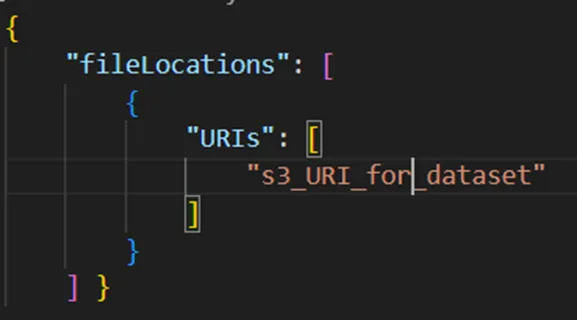
· Navigate to Quicksight in the AWS console.
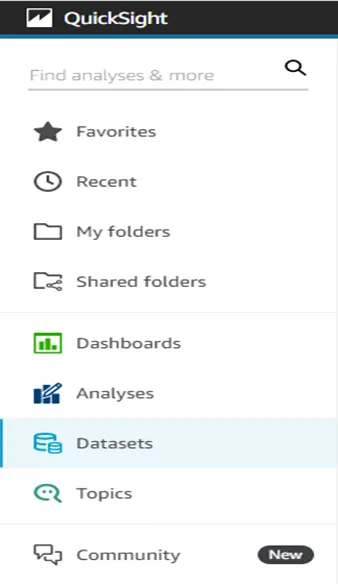
· Select the Datasets from the left side of the console.
· Click on New dataset to upload a new dataset.

· Now you will see the multiple datasources from where you can upload the data into quicksight.
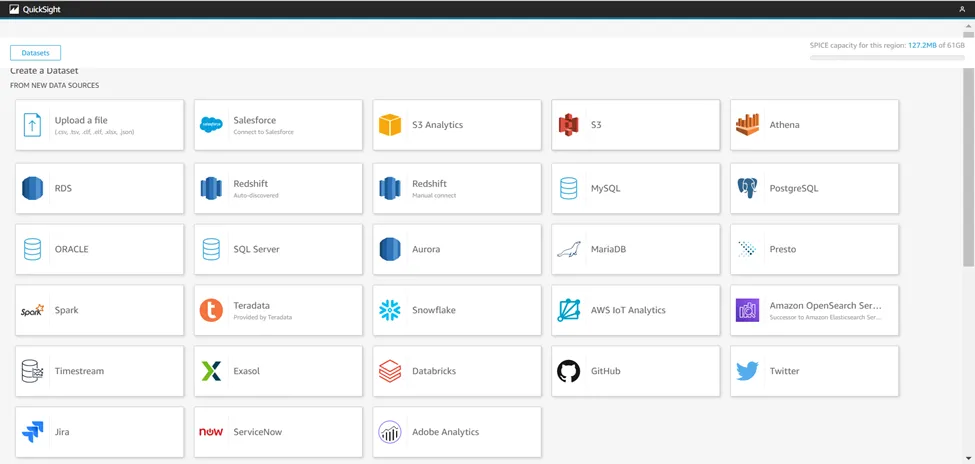
· So we are using S3 for the dataset.
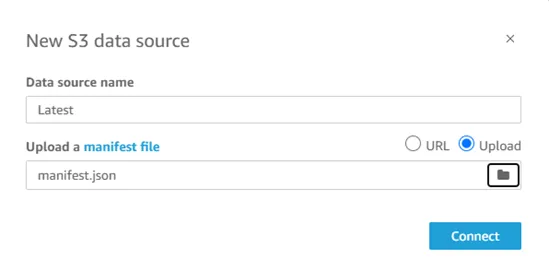
· Name the Dataset and upload the manifest file directly from the local by selecting Upload options or from S3 using URL.
· Click on connect to finish the upload.

· Here you will get the uploaded dataset which was named Latest.
Create a new analysis :
· Click on the Analyses to start the analysis and dashboards.
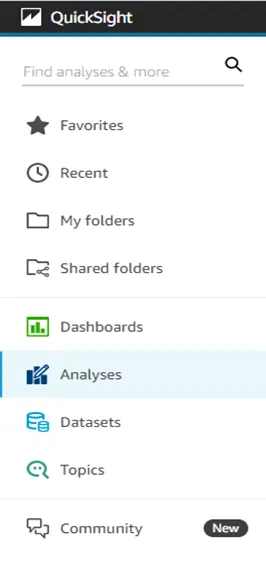
· Click on the New analysis button to start the analysis.

· Here you will be in the analysis, where you can do analysis, make dashboards and visuals.
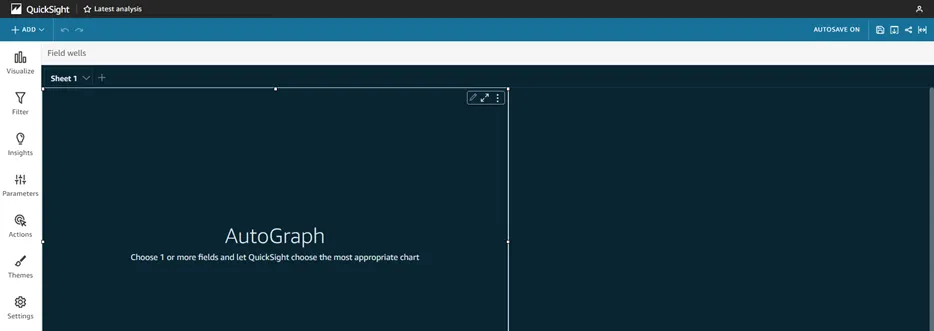
Publish the dashboard and make it publically available :
· First save the analysis.

· Click on the Save icon & name the dashboard, Click on SAVE.

· Now click on the Share icon and select Publish dashboard option as shown below

· Name the dashboard & click on Publish dashboard button.
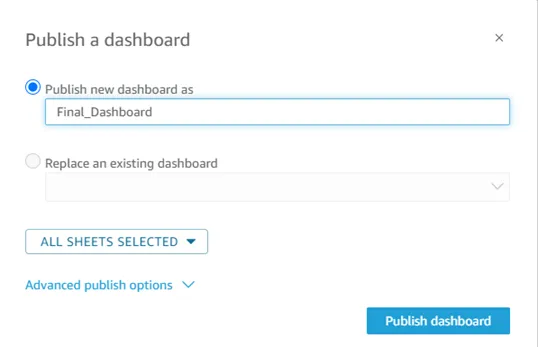
· Now Click on the share icon and select the Share dashboard option as shown below.

· You will see the option Anyone on the internet (public), just enable it.
· Copy the link by simply clicking on the Copy link.
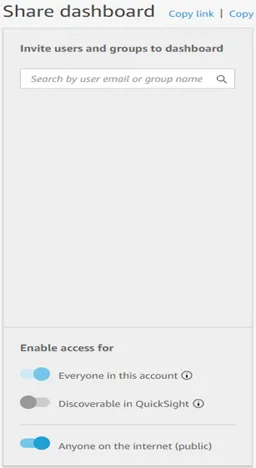
· Paste the copied link in the browser or share it to anyone to see your dashboards.
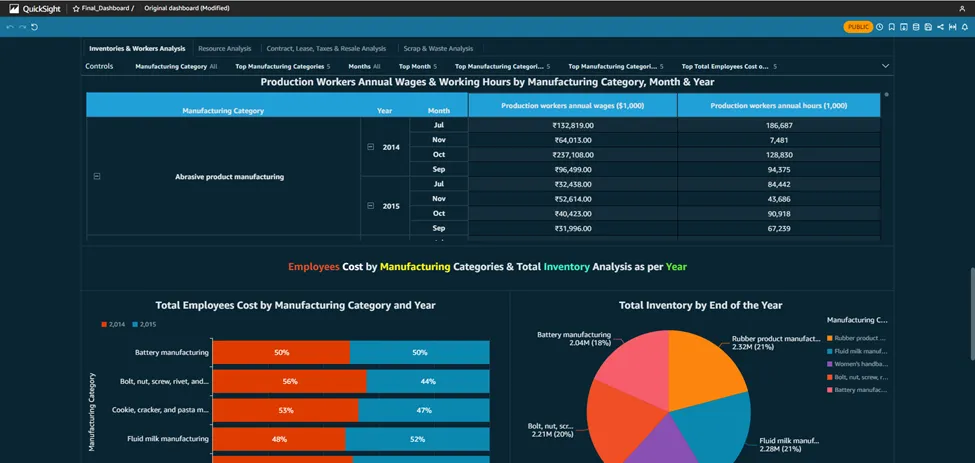
Understanding DevSecOps Concepts
DevSecOps, which stands for Development, Security, and Operations, is an approach that integrates security practices into the software development process. It emphasizes the collaboration and cooperation between development teams, security teams, and operations teams, with the goal of integrating security measures throughout the entire software development lifecycle.
There are several reasons why organizations adopt DevSecOps:
- Early Detection of Vulnerabilities: By incorporating security practices into the development process from the beginning, DevSecOps enables early detection and remediation of vulnerabilities. Security measures such as code analysis, vulnerability scanning, and penetration testing can be performed during development, reducing the chances of security issues going unnoticed until later stages.
- Rapid and Continuous Delivery: DevSecOps promotes the use of automation, continuous integration, and continuous delivery (CI/CD) pipelines. This approach enables faster and more frequent software releases while maintaining security standards. Security checks and tests can be automated and integrated into the CI/CD pipeline, ensuring that security is not compromised during the fast-paced development and deployment cycles.
- Collaboration and Shared Responsibility: DevSecOps emphasizes collaboration between development, security, and operations teams. It encourages breaking down silos and fostering a shared responsibility for security across different teams. This collaboration ensures that security considerations are not an afterthought but an integral part of the development process, leading to more secure and resilient software.
- Compliance and Regulatory Requirements: Many industries and organizations have stringent compliance and regulatory requirements concerning data protection and security. DevSecOps helps address these requirements by integrating security controls and practices into the development process. By automating security checks and documentation, organizations can demonstrate compliance more efficiently.
- Agile and Adaptive Security: DevSecOps aligns with the agile development methodology, allowing security practices to be implemented in an iterative and adaptive manner. Security measures can be continuously evaluated, improved, and adjusted based on changing threats and vulnerabilities. This enables organizations to respond more effectively to emerging security challenges.
- Enhanced Risk Management: Incorporating security into the development process allows organizations to identify and manage security risks more effectively. By addressing security concerns early on, the overall risk profile of the software can be reduced. DevSecOps provides visibility into potential risks and facilitates risk mitigation strategies.
Benefits of DevSecOps
DevSecOps, a combination of “Development,” “Security,” and “Operations,” is an approach that integrates security practices into the software development and deployment process. It emphasizes collaboration, automation, and continuous monitoring to ensure security measures are incorporated from the earliest stages of development. The benefits of DevSecOps include:
a. Early identification and mitigation of security vulnerabilities
b. Faster and more efficient software development
c. Improved collaboration and communication
d. Enhanced security awareness and culture
e. Automated security testing and monitoring
f. Continuous compliance and auditing
g. Rapid incident response and recovery
h. Cost-effectiveness
Types of Security Techniques
In DevSecOps (Development, Security, and Operations), security techniques are integrated into the entire software development lifecycle to ensure the continuous delivery of secure and reliable software. Here are some common security techniques used in DevSecOps:
i. Static Application Security Testing (SAST): SAST involves analyzing the application’s source code or binary without executing it. It helps identify security vulnerabilities, such as insecure coding practices, potential backdoors, or known vulnerabilities in third-party libraries.
ii. Dynamic Application Security Testing (DAST): DAST involves testing an application in a running state to identify vulnerabilities. It simulates attacks on the application to find security weaknesses, such as injection flaws, cross-site scripting (XSS), or improper access controls.
iii. Interactive Application Security Testing (IAST): IAST combines elements of both SAST and DAST. It instruments the application during runtime to monitor its behavior and identify vulnerabilities. It provides more accurate results by analyzing code execution paths.
iv. Security Code Reviews: Manual code reviews are performed by security experts to identify security flaws that might be missed by automated tools. This technique involves a thorough examination of the codebase, looking for vulnerabilities or insecure coding practices.
v. Security Testing Automation: Automation tools can be used to perform various security tests, including vulnerability scanning, penetration testing, and security assessment. These tools help identify common vulnerabilities efficiently and enable continuous security testing.
vi. Container Security: When using containerization technologies like Docker or Kubernetes, container security techniques are essential. This includes scanning container images for vulnerabilities, enforcing secure container configurations, and monitoring container runtime behavior.
vii. Infrastructure as Code (IaC) Security: DevSecOps also focuses on securing the infrastructure by applying security practices to infrastructure-as-code (IaC) templates. This involves implementing secure configurations, scanning IaC templates for security vulnerabilities, and performing automated security checks during infrastructure deployment.
Advantages of DevSecOps:
1. Recognize Bugs and Vulnerabilities Early.
2. Use open source with assurance.
3. Reduce resource management costs.
4. Educate developers about security.
5. Minimize Legal Liability and Risk
Conclusion:
DevSecOps promotes a proactive approach to security by integrating it into the software development lifecycle. It enables early detection of vulnerabilities, facilitates faster and more frequent releases, fosters collaboration and shared responsibility, ensures compliance with regulations, supports agile and adaptive security practices, and enhances overall risk management.
The SaaS Growth Story
Software-as-a-service (SaaS) on Cloud
Software-as-a-service (SaaS) has been around since the early 2000s and is a cost-effective alternative to the traditional IT deployment where customers have to buy or build their own IT infrastructures, install the software themselves, configure the applications and employ an IT department to maintain it all.
SaaS offers a connection and subscription to IT services built on shared infrastructure via the cloud and deployed over the internet, rather than purchased and downloaded or installed locally.
With the continuous growth of cloud computing and the clear advantages of subscription-based services, it comes as no surprise that the software as a service market continues to expand rapidly. Many organisations are committed to purchasing SaaS solutions rather than buying and hosting software internally.
Furthermore, on a SaaS provider side, this software distribution model makes it possible even for small companies, to reach a broad range of customers, opening doors to new markets and geographies.
„SaaS remains the largest public cloud services market segment, forecasted to reach $176.6 billion in end-user spending in 2022. Gartner expects steady velocity within this segment as enterprises take multiple routes to market with SaaS, for example via cloud marketplaces, and continue to break up larger, monolithic applications into compostable parts for more efficient DevOps processes.” Source: Gartner (April 2022)
Characteristics of SaaS
SEAMLESSLY AVAILABLE & SCALABLE
Uptime and the ability to respond to continually changing requirements and workloads build the basis for any successful SaaS product. Cloud provides a broad range of capabilities like x and y that can be leveraged to align with the uptime requirements of SaaS environments. It also provides dynamic scaling mechanisms that allow for the alignment of tenant consumption with the actual load.
PAY-AS-YOU-GO PRICING
Continuously managing and optimising costs is essential for SaaS providers. With the elasticity of the Cloud, they are able to build SaaS solutions that are optimised to match the infrastructure of a multi-tenant load and its scaling requirements.
GLOBAL REACH
One big advantage of the SaaS model is fast access to new markets and geographies. The availability of the public Cloud in all the principal geographic regions allows for global reach and high availability due to multi-region set-ups.
SECURITY
SaaS solutions hosted in the cloud providers can be distributed over multiple servers scattered in multiple geographical locations and have automatic backups, ensuring an extremely high level of security.
INNOVATION
The breadth and depth of tools and services available on the Cloud can facilitate a faster time-to-market for SaaS providers. The pace of innovation in the Cloud also provides SaaS companies with new services and capabilities to enhance the features, cost, and management profile of their solutions.
Making the shift: from on-prem to SaaS-enabled solutions
SaaS turns the traditional model of software delivery on its head. Rather than purchasing licenses, paying an annual maintenance fee for upgrades and support, and running applications in-house, SaaS allows organizations to buy only the number of licenses they require as their need fluctuate.
For a SaaS provider, the shift from providing on-premises solutions to becoming a SaaS-based solution provider involves intense levels of continuous testing. This means, by becoming a SaaS provider, there needs to be a shift of understanding within the organization to transform from being a software provider to a service provider.
From an operational perspective, this requires new capabilities, such as meeting service level agreements, establishing real-time usage monitoring and billing capabilities, and meeting strict security requirements.
The robust infrastructure required to provide SaaS services 24×7 requires a substantial investment.
The business challenges are even greater, ranging from the dramatically lower margins provided by SaaS, to changes in cash flow and pricing models, to requirements for customer support.
With this in mind, once a decision is made to make the shift, it will be important to rigorously evaluate the different potential SaaS models and adopt an iterative deployment approach allowing for greater learning and flexibility during the course of the deployment. Software companies and their customers should periodically assess their overall SaaS roadmap to regularly check their progress against their strategic goals.
Accelerate your SaaS journey with Ankercloud
While the advantages of a cloud-based SaaS model are strong and allow a company to focus on its core goals of developing, delivering applications, and improving its customer experience, it is important to pay special attention to key components like infrastructure budget management, capacity management, and platform availability. This is where an experienced SaaS partner like Ankercloud can be the key to a successful SaaS adoption. We support our customers on their journey to develop a SaaS model on AWS with a consolidated approach, years of experience, and deep AWS knowledge.
Curious? Reach out to us at cloudengagement@ankercloud.com
How to build a Software-as-a-Service (SaaS) product on AWS
More and more companies operating in the IT sector are born with, have switched to, or are evaluating the Software-as-a-Service (SaaS) business model as an effective way to deliver their services to customers. SaaS in the cloud is the perfect solution to leverage all the available modern tools and automated processes, but how much do you know about the optimal way to build these products on AWS?
The problem
Let’s say that your company is interested in managing a SaaS product on AWS, but you are unsure how you should approach the problem or how to start implementing a new feature that needs to be integrated with the offer. Whether you are:
- Thinking about adopting a SaaS model
- Planning to onboard a lot of new customers
- Already using SaaS, on AWS or on another platform
- Working on new license-based solutions
- Looking to modernize your whole setup or a specific part of it
- Interested in improving your DevOps pipeline
… we at Ankercloud think you could strongly benefit from the AWS SaaS Discovery Program.
The solution
Being a SaaS-certified partner and benefitting from tight cooperation with AWS, Ankercloud embarks you on a discovery journey with the aim of giving you full guidance for SaaS-related innovations, customized to your needs. That’s what the SaaS Discovery Program is all about: a period of time ranging from 2–4 weeks to be spent together, starting with technical deep dive workshops to align on your specific starting point and requirements, all the way into AWS architecture design, modernization discussions, TCO computation, best practices explanation, and much more — always suited to your business case.
But the good part does not end here: depending on your growth potential, we are able to provide the SaaS Discovery Program free of charge for you (i.e. 100% discount/funding).
High Potential use cases
The focus of the SaaS Discovery Program is always to accommodate your needs and concentrate on improving your weak points. Depending on your inputs, examples of common use cases can be:
- SaaS Design Decomposition
- Authentication and Access Management
- CI/CD Pipelines
- Database Multi-tenancy and Tenants isolation
- Security and Reliability
- SaaS DevOps
- Agility and Operations
But this list is non-exhaustive, and we at Ankercloud are always open to learning about your specific obstacles and understanding how we can support you. And here is our challenge for you: bring us your most critical SaaS-related issue, we will be happy to discuss it and bring all our deep technical knowledge to develop a solution together.
What about the outcome?
This program is intended to provide flexibility and visibility during the whole planning and discovery process. Therefore, once the program is completed, there is no obligation to further continue with the implementation of the developed solution on AWS: no commitment of any kind is in fact implied, as the name discovery suggests.
Several documents and deliverables will anyway help you in the decision-making process, giving full visibility to the planned solution. At the end of the program, Ankercloud will in fact provide you with a detailed technical report with an architecture diagram, a complete analysis of the AWS costs within an 18 months time horizon, and a full proposal to continue working together with the implementation, to give us the possibility of providing further hands-on support if needed.
Sounds interesting? Are you ready to start exploring new SaaS solutions and best practices?
Don’t hesitate to contact us at: cloudengagement@ankercloud.com
Let us guide you through the steps and check your eligibility for the SaaS Discovery Program.
Introducing ACE — our Accelerated Cloud Exploration program!
Do you have too much data to handle and analyze?
Are your IT budgets maxed out and you are unsure if Cloud is a good alternative?
Are you uncertain if Cloud aligns with your security requirements and can align with business processes?
When it comes to migrating to the cloud there are many different scenarios and challenges our customers need to assess and tackle. One of the above questions can be the trigger moment to consider migrating to or modernizing within the cloud. But what does migration imply?
When we talk about migration it could be the traditional case of a full IT migration from on-prem or one cloud provider to the other, but it can also mean bringing a large workload — like a whole Machine Learning application — into an existing infrastructure on the cloud. We also talk about a migration case when a customer is planning to add a new component to existing infrastructure or is modernizing and reshaping their cloud infrastructure.
Since there are so many possible reasons to consider choosing Cloud and every requirement and use case is unique, we have developed a new program — the Accelerated Cloud Exploration (ACE) — to help our customers assess their status quo and get full visibility on relevant stakeholders, timelines, a detailed analysis of Cost of Ownership (TCO) along with a Testbed/Sandbox when considering migrating to the cloud.
What is it?
ACE contains the components of the AWS MAP Assess phase and combines them with the substantial migration expertise and experience of Ankercloud as well as the speed and agility that we can provide through the strength of our global team.
How does it work?
The program runs in a 4–6-week time frame in which we conduct several workshops, deep dive sessions and prepare testbeds/Sandboxes together with our customers, and create a detailed report which provides you with all aspects of cloud adoption for your needs.
What is Included?
· Migration Readiness Assessment — The first workshop focuses on examining the scope and targets of a potential migration as well as shedding light on the current platform setup, governance, and security requirements by analyzing our customers’ readiness/adoption factors.
· Discovery Workshop — Once we have the business, product, and organizational alignment, we move our focus to the current technology inventory like the existing application stack and databases to then start mapping the right services and infrastructure on AWS.
· Migration Patterns and Architectures — After the Discovery Workshops, we built an exact AWS architecture that would suit your needs. We create the exact architectural diagrams, configurations and systems that enable them to adopt new cloud services or replace existing infrastructure with AWS.
· Total Cost of Ownership (TCO) Analysis –Using this architecture and understanding of your utilization, we develop an investment plan and ROI analysis for the next 36 months by accounting for post-migration AWS costs, saving costs from alternative options, and providing the correct infrastructure sizing and configurations.
· Proof of Concept (POC) — While the previous phases of this program focus on helping you get complete visibility of all facets of cloud adoption, we go one step further to help you get a direct hands-on taste of it. Within ACE, we also include a PoC to provide our customers with a sandbox environment or application on AWS to experience the advantages of a migration firsthand and get their developers a “look and feel” of their post-migration infrastructure.
· Carbon Emission Calculation — In every MAP Assess project we make use of the AWS Carbon Footprint tool which allows us to include detailed calculations and comparisons of on-prem vs. AWS CO2 emissions into the report and highlight CO2 savings for the customer.
How Much Does ACE Cost?
Depending on your current and future IT Infrastructure plans, we can provide ACE program free of charge (i.e. 100% discount/ funding).
Furthermore, after this program there is further incentivization in working with us — any follow-up activities that you would like to work on with us, for example — database and server migration, application migration, and creation of various IT environments are discounted by 50%.
And there’s more — If you do choose to migrate your workloads to AWS after the ACE program, you get 25% off on your AWS bills towards any new migrated workload for the first 36 months.
Sounds Interesting?
Our ACE Program, in collaboration with AWS, is the perfect way to start exploring the cloud as the next step in your IT or Product expansion and scaling plans. And you can now make that decision with an experienced external partner with potentially zero costs. If that sounds like an exciting proposition reach out to us at cloudengagement@ankercloud.com
Unraveling the Magic: what’s the power behind AI/ML and how to release it with AWS SageMaker
What is AI?
AI (Artificial Intelligence) refers to the field of computer science that focuses on creating intelligent machines capable of mimicking and performing tasks that typically require human intelligence. AI encompasses various subfields, such as machine learning, natural language processing, computer vision, and robotics.
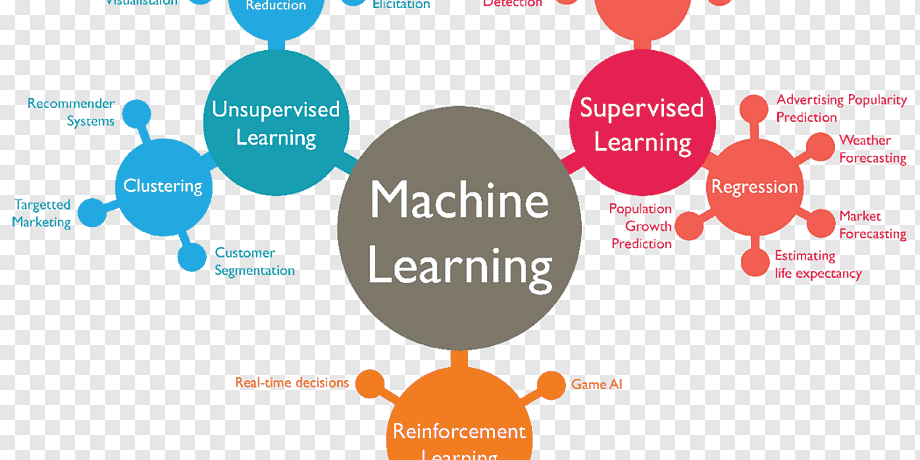
What is ML?
ML (Machine Learning) is a subset of AI that involves the development of algorithms and models that enable computers to learn from and make predictions or decisions based on data. Instead of being explicitly programmed, machine learning systems are trained on data and use statistical techniques to identify patterns and make informed decisions or predictions.
How AI/ML Works Using AWS Services?
1. Data Collection and Storage:
The foundation of AI/ML lies in data. AWS offers various services like Amazon S3, Amazon RDS, or Amazon DynamoDB for collecting, storing, and managing vast amounts of data. These services ensure secure, scalable, and reliable storage of the data required for AI/ML projects.
2. Data Preprocessing and Cleaning:
Data preprocessing is a crucial step to ensure high-quality input for ML models. AWS services like AWS Glue and AWS Data Pipeline assist in transforming, cleaning, and normalizing the data. These services automate the data preparation process, making it more efficient and accurate.
3. Training ML Models:
The training phase involves building ML models by providing data and desired outcomes. AWS SageMaker is a powerful service that simplifies the ML model training process. It offers a collaborative development environment, built-in Jupyter notebooks, and support for popular ML frameworks like TensorFlow and PyTorch.
4. ML Model Deployment:
Once the ML model is trained, it needs to be deployed to make predictions or provide insights. AWS SageMaker makes model deployment easy with its managed hosting service. Users can deploy their models as endpoints, which automatically scale based on demand.
5. Model Monitoring and Optimization:
After deployment, monitoring the ML model’s performance is crucial to ensure its accuracy and effectiveness. AWS CloudWatch integrates with SageMaker to provide real-time monitoring and alerts for model performance, resource utilization, and potential issues. This allows businesses to optimize models, detect anomalies, and address any drift in model behavior.
6. Automated ML with AWS AutoML:
AWS offers AutoML services like Amazon Comprehend and Amazon Forecast, which simplify the process of ML model development and deployment. These services use pre-built ML models and automatically train and optimize them based on the specific use case. AutoML makes AI/ML accessible to a wider audience, even those without deep ML expertise.
7. Data Visualization and Insights:
AWS QuickSight is a powerful business intelligence service that enables businesses to derive insights from their data and visualize them through interactive dashboards. QuickSight integrates seamlessly with various AWS data sources and ML models, allowing users to explore patterns, trends, and correlations in the data.
8. Advanced AI Services:
AWS offers a range of advanced AI services that leverage deep learning and natural language processing (NLP). Services like Amazon Rekognition provide image and video analysis, while Amazon Comprehend offers NLP capabilities for sentiment analysis, language detection, and entity recognition. These services enable businesses to extract valuable information from unstructured data and enhance their applications.
How Sagemaker Revolutionized the AI/ML World?
In the rapidly evolving field of Artificial Intelligence (AI) and Machine Learning (ML), staying ahead of the curve requires powerful tools and platforms that streamline the development and deployment of models. One such game-changer is Amazon SageMaker. Developed by Amazon Web Services (AWS), SageMaker has emerged as a revolutionary cloud-based platform, empowering data scientists and developers to build, train, and deploy ML models with unparalleled ease and efficiency.
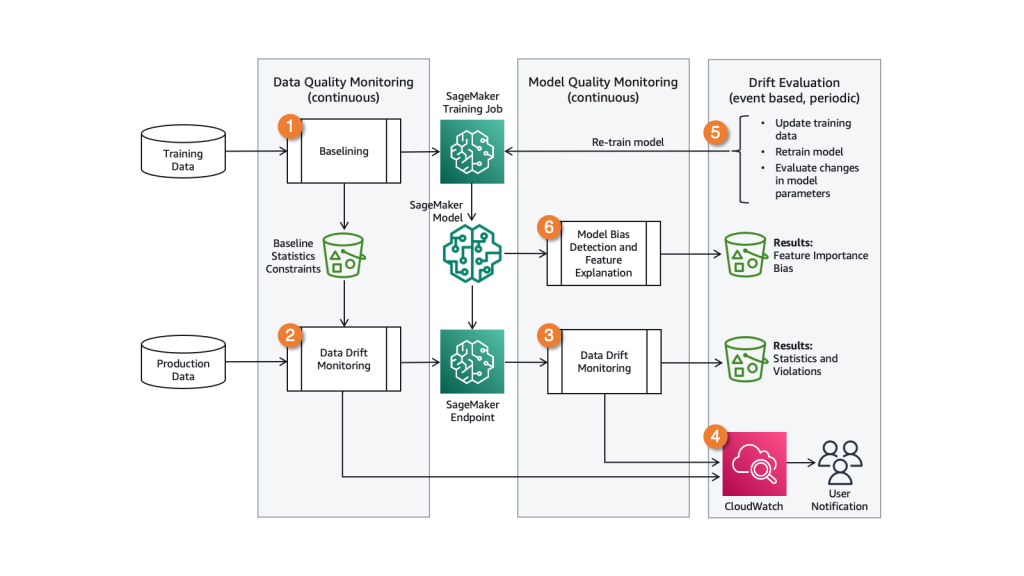
Here are some of the key impacts of SageMaker:
Simplified ML Workflow: SageMaker simplifies the end-to-end ML workflow by providing a unified environment for data preprocessing, model training, deployment, and inference. It offers a range of built-in algorithms and frameworks, as well as tools for data labeling and model tuning, making it easier for developers and data scientists to build and deploy ML models.
Scalability and Efficiency: With SageMaker, users can easily scale their ML workloads to handle large datasets and complex models. It automatically provisions the required compute resources and optimizes the training process, reducing the time and effort required to train models at scale.
Cost Savings: SageMaker offers cost-effective pricing models, such as pay-as-you-go and spot instances, allowing users to reduce ML infrastructure costs. It also provides features like automatic model scaling and resource optimization, further optimizing costs by using resources efficiently.
Built-in Tools and Frameworks: SageMaker includes a variety of pre-built ML algorithms, frameworks (such as TensorFlow and PyTorch), and optimization tools. These tools simplify the development process and enable users to quickly prototype and experiment with different models and techniques.
Easy Deployment and Management: SageMaker streamlines the deployment process by providing pre-built containers and managed hosting. It enables seamless integration with other AWS services, allowing users to easily deploy ML models as web services or integrate them into existing applications.
Collaboration and Reproducibility: SageMaker facilitates collaboration among teams by providing shared notebooks and version control integration. It allows multiple data scientists to work on the same project simultaneously, improving productivity and reproducibility.
Robust Infrastructure: SageMaker leverages the scalable infrastructure of AWS, ensuring high availability and reliability for ML workloads. It provides built-in monitoring and logging capabilities, enabling users to track model performance and troubleshoot issues effectively.
Advantages of AI/ML in Business:
1. Enhanced Efficiency and Automation:
AI/ML technologies have the potential to automate repetitive and mundane tasks, allowing businesses to optimize their operational efficiency. By automating processes like data analysis, customer support, and inventory management, companies can reduce costs, save time, and allocate resources more effectively.
2. Improved Decision Making:
AI/ML algorithms can process vast amounts of data and extract valuable insights. By analyzing patterns and trends, businesses can make data-driven decisions with greater accuracy and speed. This enables organizations to identify opportunities, predict market trends, and optimize their strategies for better outcomes.
3. Personalized Customer Experience:
AI-powered tools enable businesses to offer personalized experiences to their customers. By analyzing customer behavior, preferences, and purchasing history, companies can deliver targeted marketing campaigns, personalized product recommendations, and tailored customer support, resulting in increased customer satisfaction and loyalty.
4. Advanced Data Analytics:
AI/ML technologies can uncover hidden patterns and correlations within large datasets, providing valuable insights for businesses. These insights help identify customer preferences, market trends, and emerging risks, allowing organizations to gain a competitive edge. Data analytics powered by AI can also streamline decision-making processes and identify areas for improvement.
Disadvantages and Challenges of AI/ML in Business:
1. Lack of Human Touch:
One of the key challenges of AI/ML is the potential loss of the human touch in customer interactions. While AI-powered chatbots and virtual assistants can handle routine inquiries, they may struggle to replicate the empathy and understanding that comes from human interaction.
2. Data Privacy and Security Concerns:
AI/ML relies heavily on data, often involving sensitive customer information. This poses potential risks related to data breaches, privacy infringements, and misuse of personal data. Businesses must prioritize robust data protection measures and adhere to ethical practices to ensure the security and privacy of their customers’ information.
3. Initial Investment and Technical Challenges:
The initial costs can be high, especially for small and medium-sized enterprises (SMEs). Additionally, integrating AI/ML into existing systems and processes may pose technical challenges and require reengineering, causing disruption during the transition phase.
Why is AI Needed in Today’s World?
1. Increasing Complexity of Data:
As businesses generate and collect vast amounts of data, traditional methods of analysis and decision making are becoming inadequate. AI/ML technologies possess the ability to process and analyze complex datasets efficiently, providing valuable insights that humans may miss. This helps organizations make more informed decisions in real-time.
2. Competitive Advantage:
In today’s highly competitive marketplace, businesses need to stay ahead by offering innovative products, personalized services, and exceptional customer experiences. AI/ML enables companies to gain a competitive advantage by driving operational efficiency, improving customer satisfaction, and facilitating informed decision making.
3. Addressing Scalability and Resource Constraints:
AI/ML technologies can help businesses scale their operations by automating tasks, optimizing workflows, and reducing the reliance on human resources.
Conclusion:
AWS services have revolutionized the way AI/ML works, making it more accessible, scalable, and efficient for businesses. From data collection and preprocessing to model training, deployment, monitoring, and optimization, AWS provides a comprehensive ecosystem for AI/ML workflows. By leveraging these services, businesses can unlock the full potential of AI/ML, drive innovation, and gain a competitive advantage in the digital era.
Unleash high-performance data streaming using Amazon Kinesis
Every day we generate 2.5 quintillion bytes of data. However, only 1% of the data is processed into meaningful information due to lack of compute power. Among which most of it is generated as streaming data from a large number of sources such as social media feeds, IT logs, IoT telemetry data, online gaming, financial transactions, etc.
Streaming data is continuously generated from various sources. The stream processing technology is utilized to process streaming data in real-time. However, It is expensive to set up a large compute capacity and storage facility to process and store the streaming data.
To address this problem Amazon Web Services offers Amazon Kinesis a versatile service as the solution for challenges faced in handling and processing streaming data.
What is Amazon Kinesis?
Amazon Kinesis is a fully managed, scalable service that can ingest, buffer, and process streaming data in real-time.
Amazon Kinesis Services include Kinesis Data Stream, Kinesis Firehose, Kinesis Video Stream, and Kinesis Data Analytics.
1. Amazon Kinesis Data Streams
Kinesis Data Streams is a real-time streaming service that captures gigabytes of data from hundreds and thousands of data sources. Data streams are divided into one or more shards, each of which provides a fixed unit of capacity. Shard is the unit of base throughput for Amazon Kinesis Data Streams.
To create a stream, the number of shards has to be predefined. Each shard can support up to 5 transactions per second for reads, up to a maximum total data read rate of 2 MB per second. And up to 1,000 records per second for writes, up to a maximum total data write rate of 1 MB per second.
The total capacity of the stream is the sum of the capacities of its shards. An increase in the number of shards results in high processing speed and capacity of the data stream. Kinesis Data Streams cannot scale up in real-time if the data throughput is higher than shard capacity.
Kinesis Data Streams High-Level Architecture:
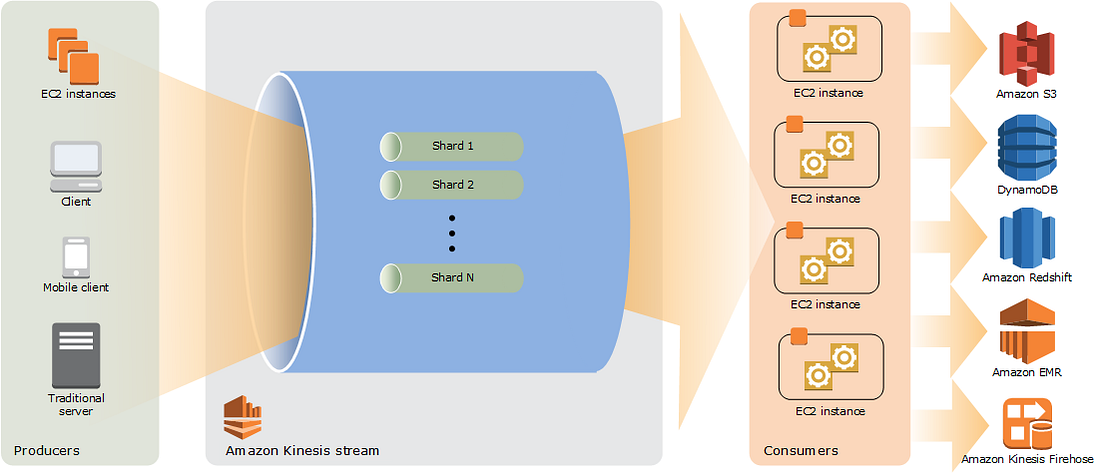
Benefits:
- Real-time performance: Streaming data is available to multiple real-time analytics applications, Amazon S3, and AWS Lambda within 70 milliseconds of the data being collected.
- Data retention: Data can be retained for seven days, the default is 24 hours.
- Secure: Data can be secured at-rest by using server-side encryption, AWS KMS master keys, and by privately accessing your data via Amazon Virtual Private Cloud (VPC).
- Low cost: Kinesis Data Streams has no upfront cost, and you only pay for the resources you use.
2. Amazon Data Firehose
Amazon Data Firehose is a near real-time service that takes care of almost everything that’s needed in capturing, transforming, and storing the data. It is a fully managed service that automatically scales to allow an increase or decrease in data throughput with no administration.
Firehose has a minimum latency of 60 seconds. It can transform and compress the data before loading it. The supported compressed formats are GZIP, ZIP, and Snappy when the target is S3.
Amazon Data Firehose provides effortless ingestion of data to data lakes such as S3, Amazon ElasticSearch, Amazon Redshift, and Splunk.
It allows the conversion of data formats before ingesting into any of the storage services, usually from JSON to Parquet or ORC and that’s only for storage in S3. It doesn’t directly convert CSV to Parquet or other formats, an AWS Lambda function can be triggered to convert CSV to JSON.
Amazon Data Firehose High-Level architecture:
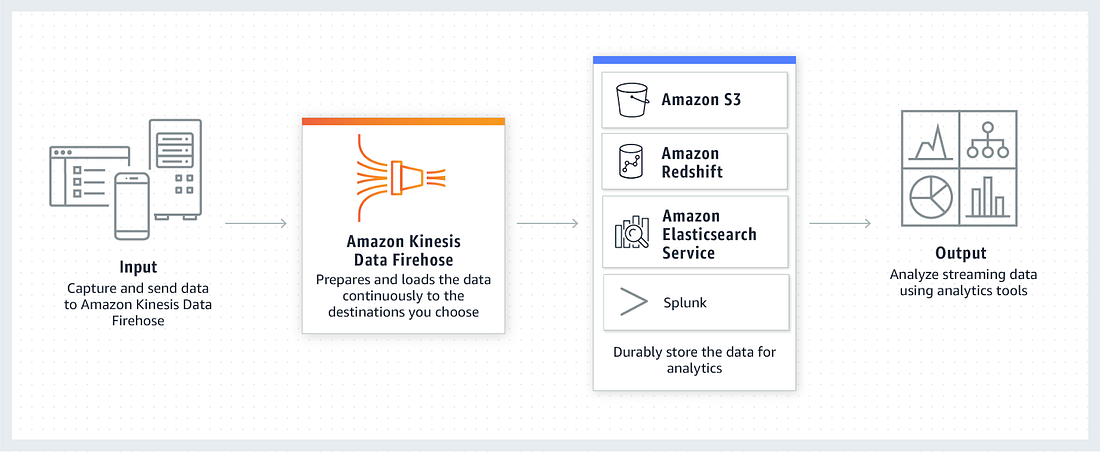
Benefits:
- Easy to use: With just a few clicks Amazon Data Firehose can be set up from AWS management console.
- Pay for only what you use: It costs only for the amount of data that is streamed. It is much cheaper compared to Kinesis Data Stream showing about 60+% saving.
- No ongoing administration: It automatically provisions, scales compute capacity, memory, and network resources required to load the streaming data.
- Serverless data transformation: Process, transform, and compress prior to downloading it to data stores.
3. Amazon Kinesis Data Analytics
Amazon Kinesis Data Analytics is a service for ETL using SQL queries on the streaming data. It analyzes and provides insights in real-time. Kinesis Data Analytics implements Amazon’s state of the art Random Cut Forest for anomaly detection. Another machine learning tool Hotspots locates and returns information about relatively dense regions in the data.
The architecture of Amazon Kinesis Data Analytics:

Benefits:
- Real-time analytics and ML: Powerful real-time analytics for ETL, and built-in real-time anomaly detection using ML.
- No servers to manage: It runs your streaming applications without requiring you to provision or manage any infrastructure.
- Pay only for what you use: pay only for the processing resources that your streaming applications use.
4. Amazon Kinesis video streams
Amazon Kinesis video streaming is a high performance and efficient streaming service for videos with very low latency rates. Videos can be streamed effortlessly in a secure manner from sources like security cameras and be stored in data stores for further analysis.
AWS AI services such as Amazon Rekognition can be utilized to get real-time insights and predictions as well as create meta data of the video streams.
The architecture of Kinesis video streams:
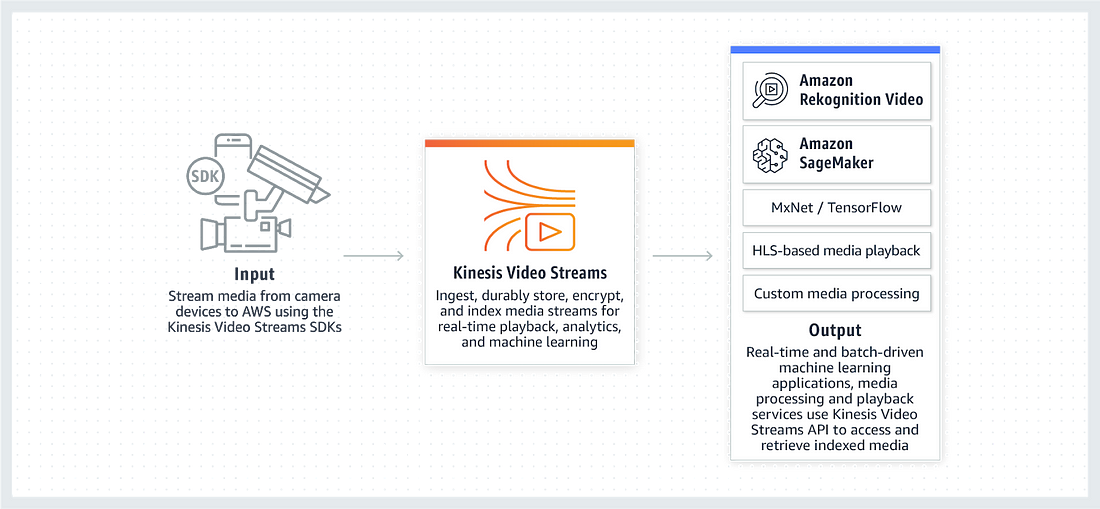
Benefits:
- Amazon Kinesis video stream is serverless and therefore saves the customer from administrative and service management overhead costs.
- Capacity to stream from millions of devices as well as build real-time applications.
Use Case of Amazon Kinesis
The architecture below depicts a use case that implements the Amazon Kinesis Services for real-time video surveillance.
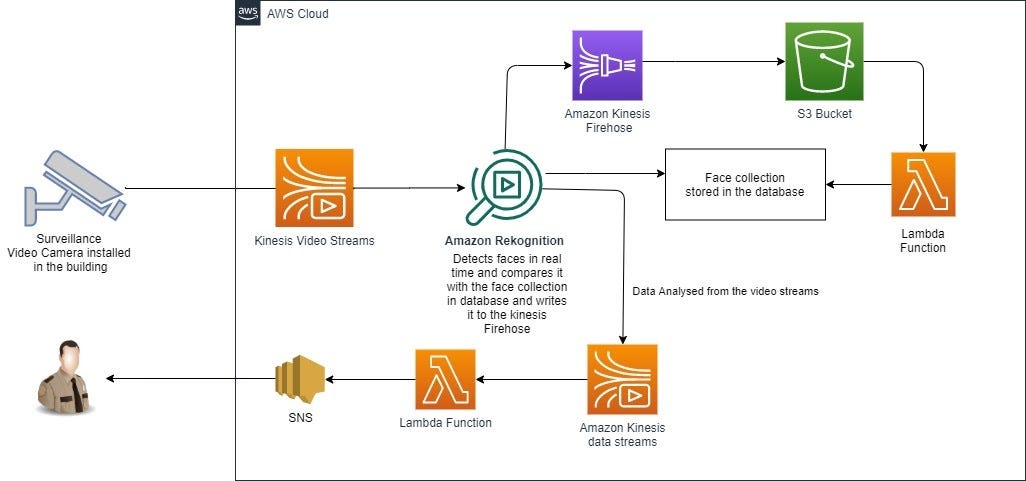
The surveillance footage from the security camera is ingested by Amazon Kinesis Video Streams.
Amazon Rekognition (a service for object and face detection) is implemented to identify faces in real-time from the video footage. Amazon Rekognition can identify known and unknown faces by comparing the faces in video streams against the faces in the S3 bucket. It can also provide the identifying features without the actual footage of faces only in the S3, where privacy is quintessential.
Amazon Kinesis Firehose streams the analyzed data from Amazon Rekognition to S3 bucket. A Lambda Function is invoked to update the face collection database every time a face is processed and stored in the S3 bucket. Simultaneously, The data analyzed by the Amazon Rekognition is written to Kinesis Data Streams which can trigger a Lambda function and invoke SNS to create a notification to the security system. This allows for immediate action in case of any security breach.
This use case demonstrates that integration of Kinesis services allows real-time analysis, monitoring, and notification which is not feasible with batch processing methods.
Conclusion
Amazon Kinesis handles streaming data, performs ETL, and real-time ML with minimal DevOps support. Amazon Kinesis is very flexible and highly reliable which makes it a very good candidate for processing as well as building applications from real-time data.
The transition from batch processing to stream processing is of great value to businesses that rely on time-sensitive data. Amazon Kinesis services empower businesses that rely on real-time applications essential for their business decisions. This saves them from spending time and energy on deploying and managing infrastructure.
Would you like to know more about AWS Kinesis or need any assistance in building a real-time application from streaming data for your business? Contact us at info@ankercloud.com.
Please Type Other Keywords
The Ankercloud Team loves to listen


